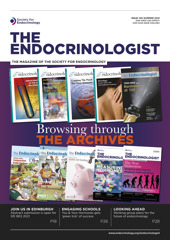Adrian J L Clark became Editor-in-Chief of the Society’s open access journal Endocrine Connections in January 2021. Here, he shares his thoughts on why open access is fundamentally important to the future of journal publishing.
The internet has radically changed so much in our lives over the last two or three decades, and scholarly publishing is no exception. In some respects, however, the changes in publishing have been slow.
The most obvious influence of the internet is in the ability to search for publications in one’s area of interest from a laptop or phone, rather than trekking over to the institutional library and scrolling through massive tomes such as Indexus Medicus, or writing down citations from other papers and then hoping that the library holds the journal you need and that the relevant volume and issue is on the shelves – frequently not the case, in my experience.
Now you can identify relevant and recent publications in a non-prejudicial way within minutes. This is a massive advance on the pre-internet struggle.
Unfortunately, accessing those papers can often falter at this point. Although you can see the abstract from your computer, you frequently cannot obtain the paper unless your institution happens to subscribe to that journal, or you or your institution is willing to pay extravagant sums to purchase a reprint.
'One major publisher reports that an open access publication will attract four times more downloads and 1.6 times more citations than traditional papers, making this form of publishing a ‘no brainer’.'
Institutional libraries are under growing financial constraints, and there is a roughly 10% annual decline in subscriptions to scholarly publications at present. Consequently, I believe that, with the exception of a handful of the top ‘coffee table’ journals, the traditional print journal and the annual journal subscription model is now facing serious decline.
The solution is open access publishing. Much of the research we publish has been supported in one form or another by public bodies: either government bodies (including the NHS and universities) or charitable organisations. Not surprisingly, they have no interest in the research they fund being limited in its distribution. Consequently, most UK and European funders will mandate that you publish open access. Add to this the fact that open access publications are downloaded and cited significantly more than ‘pay per view’ papers. One major publisher reports that an open access publication will attract four times more downloads and 1.6 times more citations than traditional papers, making this form of publishing a ‘no brainer’.
Almost a decade ago, the Society for Endocrinology, the European Society of Endocrinology and Bioscientifica saw this trend coming and launched a new endocrine journal: Endocrine Connections. They realised that a further benefit of internet searching and open access was that there was no advantage in launching a highly specialised journal. Consequently, this presented the opportunity to develop cross-disciplinary ‘connections’ within endocrine science and beyond. Now widely indexed, and with a respectable impact factor, thanks to the efforts of its two former Editors-in-Chief, Jens Sandahl Christiansen and (following Jens’ untimely death) Josef Köhrle, Endocrine Connections has come of age.
'Endocrine Connections has one of the lowest APCs amongst the endocrine journals and, as a Society member, you pay a substantially reduced rate.'
The drawback to open access publishing in many authors’ minds is the cost of the ‘article processing charge’ (APC), which is intended to compensate the publisher for the loss of income resulting from not owning the copyright to the article. Certainly, with some top of the range journals, the APCs are eye-wateringly large (indicating how profitable it is for them to publish your work and retain the copyright). It is notable that Endocrine Connections has one of the lowest APCs amongst the endocrine journals and, as a Society member, you pay a substantially reduced rate. Of course, when you publish open access, you retain the copyright and can copy, distribute, transmit and adapt the work for commercial or other purposes, provided the work is properly attributed – something that should be encouraged.
As should be well known, the profits from all Bioscientifica journals go entirely to support their parent societies, so members see the benefits of APCs in the form of meetings, travel grants and other awards, and publications such as the one you are now reading.
ADRIAN J L CLARK
Editor-in-Chief, Endocrine Connections
Emeritus Professor of Endocrinology, St George’s University of London and Honorary Professor of Endocrinology, Barts & the London, Queen Mary University of London
Read a perspective on open access from the archives in this issue






